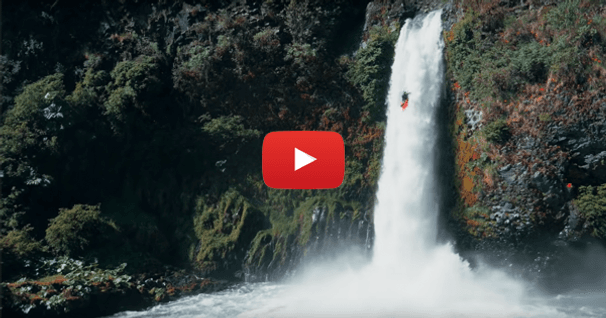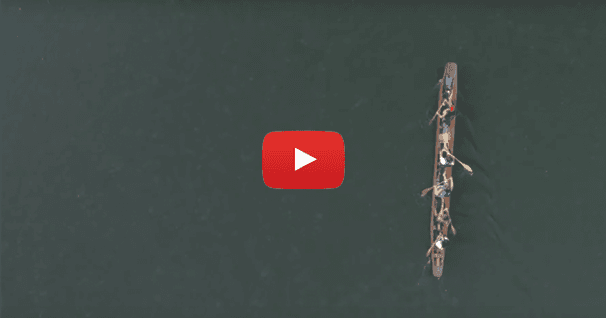Kayaking and Cree Culture in Baie-James
Now, in this episode, we're going to the land of the Cree, where the great outdoors is more than a reason to visit, it’s a way of life. Now, if you haven't ever been to Québec, what I can tell you is that it has something for everyone. Because it has lots of everything. It’s got big and energetic cities, beautiful little villages, stunning coastline, awesome food, and microbreweries. But one thing that it has more than anything else, is pristine wilderness. And so we're leaving the big cities behind and diving deep into a land rich in culture and surrounded by nature. In this episode of Paddle Tales, we're exploring Eeyou Istchee Baie-James.
As big as the state of California, but with a population of only a few thousand, Eeyou Istchee Baie-James is one of the most untouched, pristine lands in the world. For the outdoors lover, it's a paradise with countless rivers and lakes to explore. Including the biggest naturally occurring freshwater lake in the world. And an endless forest that's teeming with life.
Obviously too big to explore in a single trip, we make our way to the Chibougamau Marina, on Lake Chibougamau. A beautiful and full- service lodge that's ideally situated as a base for our trip and a great place to unwind from the long drive. The plan for today is to launch directly from the marina and explore the lake by kayak. Joining me for the paddle is Audrey Perreault from the local tourism board. Now Audrey really must have drawn the short straw, because not only is she stuck with me for the day, but she's gotta keep up paddling herself and her little one, who's expected in only a few short months. The fact that she's joining me is a testament to how the outdoors is more than just a feature of the region, it’s a way of life. So what do most people that visit this area come for?
- [Audrey] I'd say there's two main things, in the summer would be fishing, that's a really big thing. We have trophy fish like walleye, northern pike, speckled and lake trout. So people like to come here for that because the fish are quite big. And pretty much like hiking, paddling, that's kind of a thing because there's a lot of lakes, there's a lot of woods, even close to the cities and the towns its really accessible, nature is really accessible here.
- [Ken] Well there's one thing for sure, driving through this area, you're not lacking water.
- [Audrey] No!
- [Ken] Rivers, lakes, ponds, marshes.
- [Audrey] Everywhere. Pretty much everywhere you look and if you wanna go to town, get some groceries or do another activity cause there are other activities offered in town, it’s really close so you can do plenty of things and even discover the Cree culture because Oujee-Chibougamau, which is one of the closest Cree communities is just 45 minutes away. We have a beautiful museum there so that's another day trip that can be done when you're staying here.
- [Ken] I think we're gonna have to make that trip.
As we continue further down Lake Chibougamau, the sense of remoteness grows and the depth of the wilderness really comes into focus. It’s amazing to think about how many opportunities there are for adventure in this area. I mean, as beautiful as this lake is, there are literally thousands of other equally remote and unique rivers and lakes that we could have chosen to paddle. This one just made sense because we were staying at the marina. On top of that, we're only paddling about a ten mile section. And so, even on this lake, there's still a ton of room for discovery. The bottom line is that you could spend a lifetime exploring this area and still only scratch the surface. This land, is this Crown land, is this Cree land, what is this land?
- [Audrey] That's a good question. Cause our region is particular in many aspects. One of it is with the signature of the things of the northern Québec agreement. Our land was all divided into three categories: category 1 and 2 lands are reserved for the native peoples.
- [Ken] Yeah.
- [Audrey] As for category 3 lands, they are what we call public land. And in the rest of Québec, they would be called Crown lands. Anyone can go with their boat or their paddle equipment, walk around the lake, that kind of thing, that's fine. If you wanna do it in category 1 and 2 lands, you have to ask permission from the Band Council.
- [Ken] Gotcha. So we're obviously in zone three.
- [Audrey] Right now we are, yes.
- [Ken] Although there is a lot more water to explore on Lake Chibougamau, I'm really interested in learning more about the Cree of the area, who represent the largest group of First Nations in Canada.
And so I make the short drive to the community of Oujé-Bougoumou, which translated means "the place where people gather." The Oujé-Bougoumou Cree have a very long history in the region. But the village itself is quite new. After having been displaced and relocated repeatedly in the twentieth century due to mining activities, the village was completely rebuilt in the nineties. One of the key developments within the community is the Cree Cultural Institute, a museum, archive center, library and cultural center, and a place for both native and non-natives to learn about the Cree culture.
- While you're at the Cree Cultural Institute, means generations to generations. Where we teach all the crafts and arts, whether it comes with the language.
- [Ken] This is your history, here.
- It is part of history. I guess the elders knew that culture, language are slipping away, and they wanted to keep it, so they decided they needed a building. Working with the Cree nation government gives you some ideas that they wanted a place where we could keep it in a place where they could teach the younger generations that should know about a people whose culture is their identity and they wanted to keep that so they created a place.
- [Ken] Yeah. A pretty nice place. That's for sure. It really is inspiring to see what has been done with the Oujé-Bougoumou village. I'm excited to see more and so I head a few miles out of town into the bush to a place called Nuuhchimi Wiinuu Cree Cultural Tours. Here, Ann and David Bosum welcome guests year-round to share their Cree culture. The couple have built a variety of traditional dwellings that showcase how the Cree people have lived for countless years. And which guests can choose to spend the night in for the full effect.
- [Ann] So we do all kinds of activities here with the visitors. So they experience our culture in the summer time, and we also promote it in the winter.
- [Ken] People can come here, anytime of year, pretty much, and stay in one of these many different types of traditional Cree lodges. -
- [Ann] They wanna find out where they're gonna sleep, I tour them first, and then they make up their minds where they wanna sleep.
- [Ken] I've never really thought of myself as into aromatherapy but this smells good. I like the look of this. Oh wow!
- [Ann] As you see, this is one of the most traditional buildings that Crees lived in in the old days. Before they even had canvas. What you see here is all made of wood. These are sticks for roasting.
- [Ken] Ahhhhhh!
- [Ann] Last time when we had a few here, we had roast meat and we roasted it there. But there's an old story with these things, too. We have a sasquatch comes in, you can stick it.
- [Ken] Roast sasquatch. I like it. Down by the water, I find David Bosum carving away, and it’s cool to see that what he's making is a paddle. For me, the paddle is unlike any other piece of paddling gear. It’s your connection between hand and water, and in some cases, the incredible power of Mother Nature. Although the paddles that David is making are designed as much of works of art than for everyday paddling, it’s definitely symbolic of the importance that paddling and the outdoors have within the Cree culture. This is all local wood, I'm guessing.
- [David] Yeah, yeah. I don't usually get them much here, I get them out in the island.
- [Ken] What kind is that?
- [David] Red spruce. These are black spruce. The black spruce has too many knots.
- [Ken] Gotcha. And the red and green color, is that a traditional color for.
- [David] Yeah. It is supposed to make it look good.
- [Ken] Visible on the water.
- [David] Alive. Because some people say that if you make it just one color, they look sleep all the time.
As my time in the Eeyou Istchee Baie-James region comes to its end, I have to admit that I really didn't know what to expect from this trip. The truth of the matter, is that even though the highway that leads here is in great condition, you're still bearing much off the beaten path. And there isn't a ton of information or imagery out there to help set your expectations. But that's exactly what made this trip such a treat. It’s like sitting down to watch a movie that you know absolutely nothing about, only to discover that it's one of the best movies you've ever seen. I love surprises, and I love learning. And this trip has provided both with flying colors, and I'm looking forward to exploring more of this wild and wonderful region.
Related Articles
Watch the winners reel of the 2019 Kayak Session Short Film of the Year Awards. The paddlers in these…
We're heading to another place that can best be described as a wilderness paradise with beautiful…
Watch two friends, Trent McCrerey and Knox Hammack, chase water levels throughout the American West…
"For thousands of years, the Nimiipuu people piloted their canoes along the tumbling waters of the Snake…



